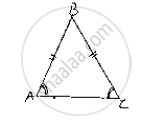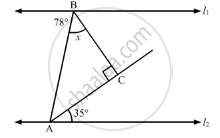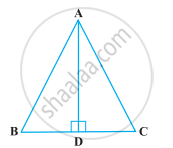Advertisements
Advertisements
प्रश्न
Fill the blank in the following so that the following statement is true.
In a ΔABC if ∠A = ∠C , then AB = ......
उत्तर
In a ΔABC if , ∠A= ∠C then AB= BC
Reason: Since, the sides opposite to equal angles are equal, the side opposite to∠A
i.e., BC and ∠C i.e., AB are equal

APPEARS IN
संबंधित प्रश्न
If the bisector of the exterior vertical angle of a triangle be parallel to the base. Show that the triangle is isosceles.
Angles A, B, C of a triangle ABC are equal to each other. Prove that ΔABC is equilateral.
Which of the following statements are true (T) and which are false (F):
The bisectors of two equal angles of a triangle are equal
Fill in the blank to make the following statement true.
If two sides of a triangle are unequal, then the larger side has .... angle opposite to it.
Write the sum of the angles of an obtuse triangle.
In the given figure, x + y =

In the given figure, for which value of x is l1 || l2?

The angles of a right angled triangle are
D is a point on the side BC of a ∆ABC such that AD bisects ∠BAC. Then ______.
ABC is an isosceles triangle with AB = AC and D is a point on BC such that AD ⊥ BC (Figure). To prove that ∠BAD = ∠CAD, a student proceeded as follows:

In ∆ABD and ∆ACD,
AB = AC (Given)
∠B = ∠C (Because AB = AC)
and ∠ADB = ∠ADC
Therefore, ∆ABD ≅ ∆ACD (AAS)
So, ∠BAD = ∠CAD (CPCT)
What is the defect in the above arguments?
[Hint: Recall how ∠B = ∠C is proved when AB = AC].
